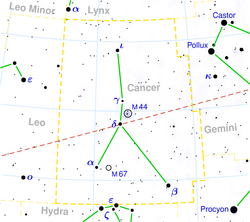Beta Cancri
| Observation data Epoch J2000 Equinox J2000 | |
|---|---|
| Constellation | Cancer |
| Right ascension | 08h 16m 30.9206s[1] |
| Declination | +09° 11′ 07.961″[1] |
| Apparent magnitude (V) | 3.50 - 3.58[2] |
| Characteristics | |
| Spectral type | K4III Ba1[3] |
| U−B color index | +1.77[4] |
| B−V color index | +1.48[4] |
| Astrometry | |
| Radial velocity (Rv) | 22.94[5] km/s |
| Proper motion (μ) | RA: −46.80[1] mas/yr Dec.: −48.65[1] mas/yr |
| Parallax (π) | 11.23 ± 0.97[1] mas |
| Distance | 290 ± 30 ly (89 ± 8 pc) |
| Absolute magnitude (MV) | −1.218[6] |
| Details | |
| Radius | 61[7] R☉ |
| Luminosity | 871[7] L☉ |
| Surface gravity (log g) | 1.5[7] cgs |
| Temperature | 3,990[7] K |
| Metallicity | −0.24[7] |
| Rotational velocity (v sin i) | 6.9[7] km/s |
| Other designations | |
| Database references | |
| SIMBAD | data |
Beta Cancri (β Cancri, abbreviated Beta Cnc, β Cnc), also named Tarf /ˈtɑːrf/,[9] is the brightest star in the zodiacal constellation of Cancer. It has an apparent visual magnitude of +3.5[2] and an absolute magnitude of −1.2.[6] Based on parallax measurements obtained during the Hipparcos mission, it is approximately 290 light-years distant from the Sun.[1] An exoplanet, designated Beta Cancri b, is believed to be orbiting the star.[10]
Beta Cancri has a companion listed and together they are designated WDS J08165+0911. As the primary, Beta Cancri bears the designation WDS J08165+0911A.[8] The companion is designated WDS J08165+0911B.[11]
Nomenclature[edit]
β Cancri (Latinised to Beta Cancri) is the star's Bayer designation. WDS J08165+0911A is its designation in the Washington Double Star Catalog.[8]
The star bore the traditional name of Al Tarf (anglicized as Altarf[12]), which can be translated from the Arabic as "end" or "edge".[13] In 2016, the IAU organized a Working Group on Star Names (WGSN)[14] to catalog and standardize proper names for stars. The WGSN approved the name Tarf for Beta Cancri on 1 June 2018 and it is now so included in the List of IAU-approved Star Names.[9]
Properties[edit]
Beta Cancri is an orange K-type giant, about 50 times the radius of the Sun.[13] It is Barium star, a type of cool giant showing enhanced abundances of Barium.[15] It is also suspected to vary slightly in brightness.[2]
The companion is a red dwarf of the fourteenth magnitude. From its angular distance of 29 arcseconds, the companion's distance from Beta Cancri is estimated at some 2600 AU, with an orbital period of 76,000 years.[13]
Planet[edit]
In 2014 evidence was presented of a planet orbiting Beta Cancri. Using radial velocity data from repeated observations of the star, the planet is estimated to have a minimum mass of approximately 7.8 times that of Jupiter, and an orbital period of 605 days.[10]
| Companion (in order from star) |
Mass | Semimajor axis (AU) |
Orbital period (days) |
Eccentricity | Inclination | Radius |
|---|---|---|---|---|---|---|
| b | 7.8 ± 0.8 MJ | 1.7 ± 0.1 | 605.2 ± 4.0 | 0.08 ± 0.02 | — | — |
References[edit]
- ^ a b c d e f Van Leeuwen, F. (2007). "Validation of the new Hipparcos reduction". Astronomy and Astrophysics. 474 (2): 653. arXiv:0708.1752. Bibcode:2007A&A...474..653V. doi:10.1051/0004-6361:20078357.
- ^ a b c Samus, N. N.; Durlevich, O. V.; et al. (2009). "VizieR Online Data Catalog: General Catalogue of Variable Stars (Samus+ 2007-2013)". VizieR On-line Data Catalog: B/gcvs. Originally Published in: 2009yCat....102025S. 1. Bibcode:2009yCat....102025S.
- ^ Lu, Phillip K. (1991). "Taxonomy of barium stars". Astronomical Journal. 101: 2229. Bibcode:1991AJ....101.2229L. doi:10.1086/115845.
- ^ a b Mermilliod, J.-C. (1986). "Compilation of Eggen's UBV data, transformed to UBV (unpublished)". Catalogue of Eggen's UBV Data. Bibcode:1986EgUBV........0M.
- ^ Famaey, B.; Jorissen, A.; Luri, X.; Mayor, M.; Udry, S.; Dejonghe, H.; Turon, C. (2005). "Local kinematics of K and M giants from CORAVEL/Hipparcos/Tycho-2 data. Revisiting the concept of superclusters". Astronomy and Astrophysics. 430: 165. arXiv:astro-ph/0409579. Bibcode:2005A&A...430..165F. doi:10.1051/0004-6361:20041272.
- ^ a b Cassatella, A.; Altamore, A.; Badiali, M.; Cardini, D. (2001). "On the Wilson-Bappu relationship in the Mg II k line". Astronomy and Astrophysics. 374 (3): 1085. arXiv:astro-ph/0106070. Bibcode:2001A&A...374.1085C. doi:10.1051/0004-6361:20010816.
- ^ a b c d e f Massarotti, Alessandro; Latham, David W.; Stefanik, Robert P.; Fogel, Jeffrey (2008). "Rotational and Radial Velocities for a Sample of 761 HIPPARCOS Giants and the Role of Binarity". The Astronomical Journal. 135: 209. Bibcode:2008AJ....135..209M. doi:10.1088/0004-6256/135/1/209.
- ^ a b c "bet Cnc -- High proper-motion Star", SIMBAD, Centre de Données astronomiques de Strasbourg, retrieved 2018-06-26
- ^ a b "Naming Stars". IAU.org. Retrieved 18 June 2018.
- ^ a b Lee, B.-C.; Han, I.; Park, M.-G.; Mkrtichian, D. E.; Hatzes, A. P.; Kim, K.-M. (2014). "Planetary companions in K giants β Cancri, μ Leonis, and β Ursae Minoris". Astronomy & Astrophysics. 566: A67. arXiv:1405.2127. Bibcode:2014A&A...566A..67L. doi:10.1051/0004-6361/201322608.
- ^ "UCAC4 496-050758 -- Star", SIMBAD, Centre de Données astronomiques de Strasbourg, retrieved 2018-06-26
- ^ Hoffleit, D.; Warren, W. H. (1995). "VizieR Online Data Catalog: Bright Star Catalogue, 5th Revised Ed. (Hoffleit+, 1991)". VizieR On-line Data Catalog: V/50. Originally Published in: 1964BS....C......0H. 5050. Bibcode:1995yCat.5050....0H.
- ^ a b c Kaler, James B. "AL TARF (Beta Cancri)". Stars. University of Illinois. Retrieved 2010-02-23.
- ^ "IAU Working Group on Star Names (WGSN)". Retrieved 22 May 2016.
- ^ Gomez, A. E.; Luri, X.; Grenier, S.; Prevot, L.; Mennessier, M. O.; Figueras, F.; Torra, J. (1997). "Absolute magnitudes and kinematics of barium stars". Astronomy and Astrophysics. 319: 881. Bibcode:1997A&A...319..881G.
- ^ "Notes on beta Cnc b". Extrasolar Planets Encyclopaedia. Retrieved 28 February 2017.
